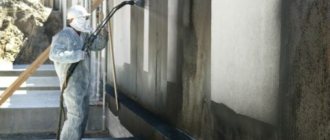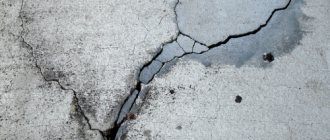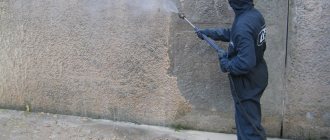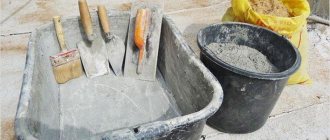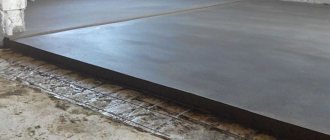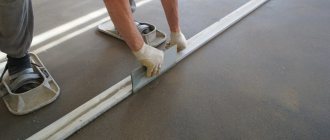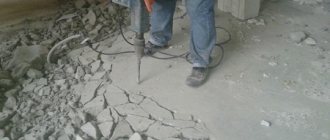The exclusivity of lithium lies in its affinity with metals and alkali. Because of this, lithium impregnation for concrete does not react with the alkaline environment of the cement mixture. It penetrates into the pores of the prepared solution and does not disappear from the surface throughout its service life. For this reason, lithium impregnation protects the screed from chemical and mechanical influences for a long period of time.
How does lithium impregnation work?
This impregnation is applied to the concrete surface with a sponge, brush or spray.
Moreover, due to the low density of lithium itself, the impregnation is literally absorbed by the concrete, penetrating to a considerable depth. And along the entire path, the molecules of lithium impregnation react with the base of the cement stone - calcium hydroxide, forming a new silicate group that protects both the surface layers of the concrete screed and its deep structure.
What is the advantage of lithium impregnation?
Who produces lithium impregnations?
Among the popular lithium impregnations are the following brands:
Examples of manufacturers
There are several well-known manufacturers of lithium impregnations. Among which stand out:
- . The company's product range includes C2 Hard impregnations to increase the hydrophobicity of cement and reinforced concrete surfaces and to protect against dust formation. Protectors C2 Seal, C2 Gloss are included in the group of reinforcing compounds with decorative properties.
- Russian, which produces hardening solutions of the same name that increase the hardness of loose concrete and also gives them fire resistance.
- , which produces products for treating old and new surfaces in crowded areas. The impregnation of this brand is characterized by the high-tech properties of the Superpol product category.
In addition to foreign brands, Russian products are especially popular, the list and main characteristics of which are presented below.
Return to contents
Pentra-Protect
The product is intended for surface treatment in parking lots, production facilities, and service areas. The protector is used when laying roads and piers.
Pentra-Protect has good oil-repellent properties that effectively protect against stains, greasy and flammable materials. Due to the property of water repellency, treated surfaces resist the effects of moisture, water pollutants, and microorganisms. The composition penetrates deeply, leaving no traces on top, without changing the external qualities of concrete. After treatment, the surface does not lose its ability to breathe and becomes easy to maintain.
Return to contents
Lithurin
Liquid hardener Lithurin also penetrates deep into the stone, binding and hardening its structure. The balanced water-based formula does not change color and does not create a film. The surface becomes denser, more resistant to abrasion and light chemicals, and acquires water-repellent and anti-slip properties. Therefore, Lithurin is used in food industry premises. The hardener does not harm human health or the environment. It can be used to treat surfaces of any age made of different materials. A special feature of Lithurin is its self-polishing property, that is, the more wear the floor has, the better its appearance.
Impregnation has a wide range of applications. Along with food industry premises, the hardening solution is available for treating public places (shops, shopping centers, airports, railway and bus stations, garages, parking lots, warehouses, basements).
Return to contents
FloorHard Lithium
A special feature of the FlorHard Lithium hardener is its speed of action. The dust-free property appears after 24 hours, increased strength - after 14 days, the maximum set of properties - after six months. FloorHard Lithium is used for processing warehouses, open and underground parking lots, industrial premises, markets, shopping centers, etc. The impregnation can be applied to freshly laid or mature concrete.
The hardener gives concrete resistance to abrasion, dust, chemicals, abrasive substances, mechanical stress, low temperatures, and moisture. The treated surface is easy to maintain and polish.
Return to contents
Other hardeners
No less popular are such products of domestic and foreign production as Ashford Formula, Liqui-Hard, Liqui-Hard Ultra, Alkali Silica Reaction ASR, Isomat BI-100 and other compositions.
Return to contents
Application technologies, introduction of hardeners from silicate and lithium
Lithium impregnations can be applied to a concrete surface about a month after it is poured. If it is impossible to wait that long, then the product is applied to fresh concrete, but only after applying seams and grouting to it.
Silicate impregnations are applied similarly to lithium impregnations. The surface is cleaned of dirt. Fine dust after concrete grinding is also completely removed. The air temperature indoors or outdoors should be no lower than 4 degrees Celsius, but not higher than 38 degrees.
As a result, the floor with additional strengthening impregnation is a kind of layer cake. This design consists of the following layers:
- a cushion of sand and crushed stone that serves as a base for concrete;
- special film made of polyethylene;
- a layer of concrete of the required thickness;
- a layer of topping made from a special dry mixture;
- finishing impregnation.
Despite the fact that this design seems quite complicated at first glance, it has a number of advantages and makes the concrete floor much stronger than the same composition, but without additional fastening.
Option for applying lithium impregnation for concrete floors
Types of compositions
According to the areas of application, deep penetration primers are divided into waterproofing and strengthening:
- waterproofing mixtures are used on objects in contact with liquids (swimming pools, tanks, oil storage facilities);
- strengthening agents are applied to structures with increased mechanical load (industrial enterprises, warehouses, workshops, service stations, parking lots, garages).
Concrete impregnations are one- or two-component compositions, where a chemical component is used as a filler. Based on this criterion, impregnations are classified into organic and inorganic preparations.
Organic hardeners are binders made from epoxy resins, polyurethane, or acrylates. When in contact with concrete, they form a dense film on its surface, which protects the material from dust, moisture, pollution, and aggressive chemical environments. Impregnation also penetrates into the pores and microcracks of the upper layers of concrete, and after hardening increases their strength.
Inorganic mixtures are deep penetration compositions based on silicates (silanes, silaxins) or fluates. They penetrate much deeper into the pores of concrete, where they come into contact with lime particles. As a result of a chemical reaction, calcium crystals are formed, which increase the strength and water resistance of the structure. Treated concrete becomes an inert material that effectively withstands the negative effects of the environment.
Inorganic drugs
Inorganic primers (silicate, lithium, fluate) are perfectly absorbed even into a dense, low-porosity structure. They are used to treat the following surfaces:
- dense coatings with a small number of pores;
- concrete slabs and high-strength concrete grades M350 and higher;
- polymer cement and magnesium materials;
- concrete grades M150-300 (strengthening the structure);
- wet surfaces;
- concrete structures with poor quality waterproofing.
Silicate impregnations have maximum water-repellent properties. Due to their liquid consistency, they are rarely applied to vertical surfaces, but are actively used to strengthen open horizontal structures: pedestrian crossings, parking lots, bridge structures. Silicate-based liquids protect concrete from snow, rain, and chemicals. The surface is treated once, and the service life of the coating is more than 10 years.
Lithium impregnations are most often used to “rejuvenate” worn concrete. They penetrate the canvas to a great depth and strengthen it and prevent destruction. After applying the drug, there are no weak zones or cold bridges left in the concrete layers. Impregnation is characterized by minimal consumption: about 1 liter of hardener is used per 10 m2 of canvas.
Preparations based on fluates protect concrete from premature destruction and dust formation. The solution is heated and applied to the surface in several layers. Fluates reduce the abrasion of the canvas and are often used at the preparatory stage before applying paints and varnishes.
Inorganic impregnations for concrete not only prevent capillary absorption of moisture, but also increase frost resistance and maintain the vapor permeability of the material.
Organic Blends
Polymer impregnations (acrylic, epoxy, polyurethane) are often used to treat porous surfaces:
- cellular concrete (aerated concrete and foam concrete);
- lightweight concrete (expanded clay, perlite, tuff, pumice);
- outdoor and indoor concrete, stone, brick structures.
After the impregnation dries, a uniform glossy film is formed on the surface of the canvas, which does not require additional sanding or processing. The average service life of an organic coating is from 2 to 5 years.
Acrylic-based impregnations are ineffective and short-lived. The average service life of the coating does not exceed 2 years. Acrylic solutions are used to strengthen internal unloaded structures: floors, walls in a residential building. Due to their cheap chemical composition, organic acrylate mixtures have a low price. The finished coating has a smooth structure and is resistant to chloride compounds, ultraviolet radiation and dust.
Polyurethane impregnations are the most popular and are used even in nuclear energy, healthcare, and the food industry. The compositions penetrate concrete to a depth of 6 mm and effectively protect the canvas from dust, dirt, mechanical shock, as well as the formation of cracks and chips. Organic impregnations based on polyurethane increase the frost resistance and grade strength of concrete structures up to M600. It is used in warehouses, garages, parking lots, production workshops, and public places. Polyurethane-based mixtures do not withstand exposure to water.
Organic impregnations based on epoxy resin are the most effective preparations for interior work. They are characterized by minimal moisture permeability, do not shrink and have high strength characteristics. However, such impregnations crack and fade under the influence of ultraviolet radiation. Epoxy mixtures are used in the construction of children's and medical institutions, warehouses, and swimming pools.
The need to use impregnations for concrete
The presence of micropores causes two main disadvantages of this material:
- low hydrophobicity. Moisture seeps through the pores;
- insufficient concrete density, which reduces the strength of the finished floor.
Modern technologies make it possible to transform the porous structure of concrete and turn it into waterproof stone, which is especially important when creating concrete surfaces in contact with moisture.
The following problems are solved with the help of concrete impregnations:
Operating principle
Concrete treated with these impregnations does not generate dust and does not require further processing.
The lithium-based protector contains complex polysilicates. These substances easily permeate the porous structure of concrete stone. During the reaction, portlandite and chalk are transformed into calcium hydrosilicate - a solid, chemically stable compound with a microcrystalline, less often lamellar, structure. Such a strong binding component strengthens and compacts the cement, increasing its resistance to any impact. Impregnation works throughout the life of the stone. It does not matter at what stage the processing is carried out. The protector works even on old concrete or stone floors.
Return to contents
Functional properties of impregnations
Depending on the functionality, concrete impregnations are divided into:
- strengthening;
- water-repellent;
- dust removal;
- coloring.
Strengthening impregnations
Water-repellent impregnations
Water-repellent (water-repellent) impregnations penetrate into the pores and cracks of concrete, protecting it from moisture penetration and the effects of such negative factors as:
- microorganisms, mold, fungi;
- salt/acid precipitation;
- UV rays;
- formation of efflorescence.
Dust-removing impregnations
Anti-dust compounds are used for the following purposes:
Coloring compounds
Concrete can be painted with regular paint or with a special colored impregnation. Painted surfaces are less durable. With constant traffic/traffic loads, the paint layer cracks and peels off.
What are they used for?
Lithium impregnation is actively used at the final stage of pouring concrete screed. This substance provides waterproofing, dust removal of the surface, and protects against grease, oil, and gasoline. That is why it is customary to treat industrial floors with such impregnation, which are subject to frequent aggressive influences and mechanical stress. The lithium-based protector prevents dusting that occurs during partial destruction with the appearance of cracks in concrete. Consequently, it eliminates the harmful effects of dust on the health of workers and equipment.
The range of impregnations on the modern market is large. All of them are endowed with different properties, so their scope is wide. Protectors are available with basic or decorative properties that can be used in residential construction.
Return to contents
Classification
It is customary to distinguish between sealing, strengthening and hydrophobic liquid impregnations . In the first case, a wear-resistant top layer is obtained, but it quickly wears out during operation. That is why such materials are recommended to be used in combination with strengthening dry mixtures or impregnations.
Reinforcing varieties are a more effective option. They are able to penetrate into the structure of artificial stone, preventing dust and destruction of concrete . These materials are applied once for the entire service life of the concrete. Unlike dry toppings, the application of liquid hardeners does not require troweling, but the finished surface is not much different from a standard concrete floor. In addition, in some cases it is possible to obtain a colored layer.
The most popular and in demand liquid impregnation with high strengthening properties is Ashford Formula (USA). But there are brands that constitute significant competition, for example, liquid hardeners Monopol, Polymerstone, Elakor (Russia), Liturin (Sweden, Liturine), Sika CureHard (Switzerland, Sika CureHard).
Our new phone numbers
Dear customers, colleagues and partners! We inform you about the change in landline phone numbers from August 4th. Our new phone numbers: +375 (17) 270-70-31 +375 (17) 270-70-32 +375 (17) 270-70-33 +375 (17) 270-70-34 Mobile phone number A1
more details
conclusions
Currently, lithium and silicate impregnations for concrete have shown maximum efficiency . They provide better performance characteristics of the finished coating (especially when paired with membrane formers) and can work indoors and outdoors in places for various purposes. However, application can only be carried out at positive temperatures and on durable concrete, which is not always appropriate.
High decorative properties are provided by colored liquid impregnations , and one-component polyurethane varieties can be used even at low temperatures, down to -30 degrees, which in itself is a significant plus.
To ensure hydrophobic properties, special moisture-resistant liquid impregnations become indispensable. Their advantage is versatility. In addition to horizontal bases, the material works on concrete facades, columns, walls, etc.
More details and more clearly about hydrophobic liquid impregnations for concrete and other building structures are shown in the video:
Safety precautions
When working with liquid impregnations for concrete, it is necessary to use personal protective equipment - this will prevent the materials from getting on the skin, mucous membranes, and the digestive tract. To protect workers, respirators equipped with P100 filters, special shoes, clothing, gloves, mittens, and goggles are used.
Persons at least 18 years of age who have undergone a medical examination, instruction, and training are allowed to paint. When working with an electric tool, it must be grounded.
Manufacturers of chemical impregnations recommend observing product storage standards. Impregnations are placed in a specially designated place where there are no sources of open flame or ignition . If the container with the composition is opened, do not use a tool that could cause a spark to form upon impact.



